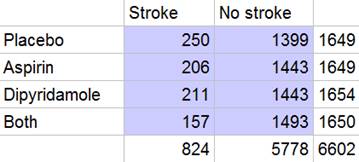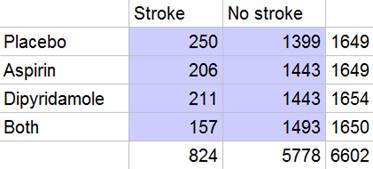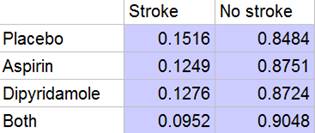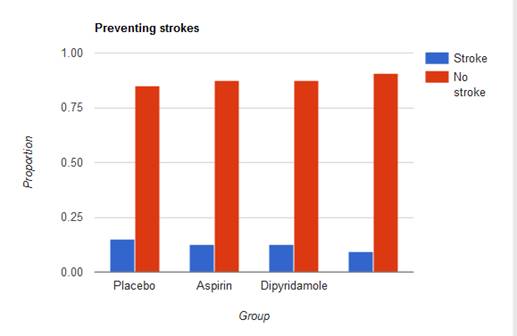
(a)
To summarize these data in a two-way table.
(a)
Explanation of Solution
In the question, it is given that aspirin prevents blood from clotting and so help prevent strokes. Thus, the data on the strokes for the two-year study is given in the question. Thus, the summary of these data in a two-way table can be represented by the number of no strokes is the number of patients decreased by the number of strokes, that is,

(b)
To make a graph to compare the success rates for the four treatments and describe what you see.
(b)
Explanation of Solution
In the question, it is given that aspirin prevents blood from clotting and so help prevent strokes. Thus, the data on the strokes for the two-year study is given in the question. Thus, the summary of these data in a two-way table can be represented by the number of no strokes is the number of patients decreased by the number of strokes, that is,

So therefore the proportion in each group is the number of strokes/ no strokes divided by the row total given in the last column is calculated as:

Thus, the graph to compare the success rates for the four treatments can be constructed as:

Thus, by looking at the histogram we note that the proportions of strokes/no strokes do not seems to vary much by group.
(c)
To explain in words what the null hypothesis
(c)
Answer to Problem 38E
It says proportion of successes for each treatment is the same.
Explanation of Solution
In the question, it is given that aspirin prevents blood from clotting and so help prevent strokes. Thus, the data on the strokes for the two-year study is given in the question. Thus, the summary of these data in a two-way table can be represented by the number of no strokes is the number of patients decreased by the number of strokes, that is,

Thus, it is given the null hypothesis in the question as:
And the null hypothesis says about the subjects’ smoking habits that this means that the proportion of successes for each treatment is the same.
(d)
To find the expected counts if null hypothesis is true and display them in a two-way table of observed counts.
(d)
Explanation of Solution
In the question, it is given that aspirin prevents blood from clotting and so help prevent strokes. Thus, the data on the strokes for the two-year study is given in the question. Thus, the summary of these data in a two-way table can be represented by the number of no strokes is the number of patients decreased by the number of strokes, that is,

Thus, it is given the null hypothesis in the question as:
Thus, the expected counts are the row total multiplied by the column total, divided by the

Chapter 11 Solutions
The Practice of Statistics for AP - 4th Edition
Additional Math Textbook Solutions
Intro Stats, Books a la Carte Edition (5th Edition)
Introductory Statistics (10th Edition)
Essentials of Statistics (6th Edition)
Elementary Statistics: Picturing the World (6th Edition)
Statistics for Business and Economics (13th Edition)
Statistics: The Art and Science of Learning from Data (4th Edition)
 MATLAB: An Introduction with ApplicationsStatisticsISBN:9781119256830Author:Amos GilatPublisher:John Wiley & Sons Inc
MATLAB: An Introduction with ApplicationsStatisticsISBN:9781119256830Author:Amos GilatPublisher:John Wiley & Sons Inc Probability and Statistics for Engineering and th...StatisticsISBN:9781305251809Author:Jay L. DevorePublisher:Cengage Learning
Probability and Statistics for Engineering and th...StatisticsISBN:9781305251809Author:Jay L. DevorePublisher:Cengage Learning Statistics for The Behavioral Sciences (MindTap C...StatisticsISBN:9781305504912Author:Frederick J Gravetter, Larry B. WallnauPublisher:Cengage Learning
Statistics for The Behavioral Sciences (MindTap C...StatisticsISBN:9781305504912Author:Frederick J Gravetter, Larry B. WallnauPublisher:Cengage Learning Elementary Statistics: Picturing the World (7th E...StatisticsISBN:9780134683416Author:Ron Larson, Betsy FarberPublisher:PEARSON
Elementary Statistics: Picturing the World (7th E...StatisticsISBN:9780134683416Author:Ron Larson, Betsy FarberPublisher:PEARSON The Basic Practice of StatisticsStatisticsISBN:9781319042578Author:David S. Moore, William I. Notz, Michael A. FlignerPublisher:W. H. Freeman
The Basic Practice of StatisticsStatisticsISBN:9781319042578Author:David S. Moore, William I. Notz, Michael A. FlignerPublisher:W. H. Freeman Introduction to the Practice of StatisticsStatisticsISBN:9781319013387Author:David S. Moore, George P. McCabe, Bruce A. CraigPublisher:W. H. Freeman
Introduction to the Practice of StatisticsStatisticsISBN:9781319013387Author:David S. Moore, George P. McCabe, Bruce A. CraigPublisher:W. H. Freeman





